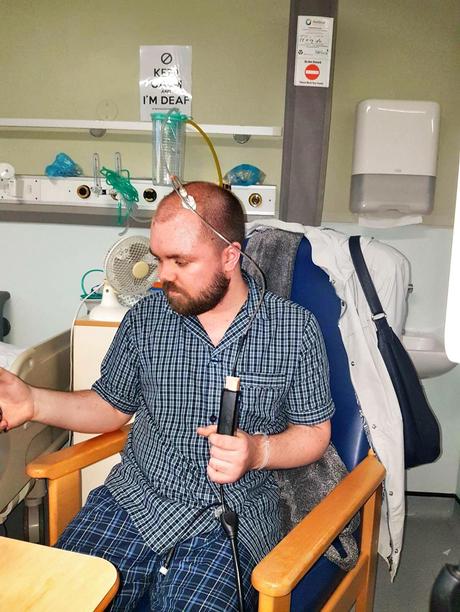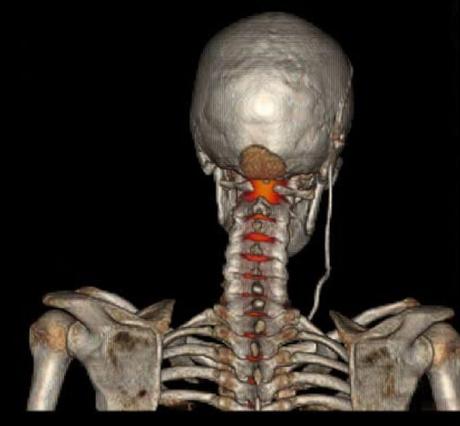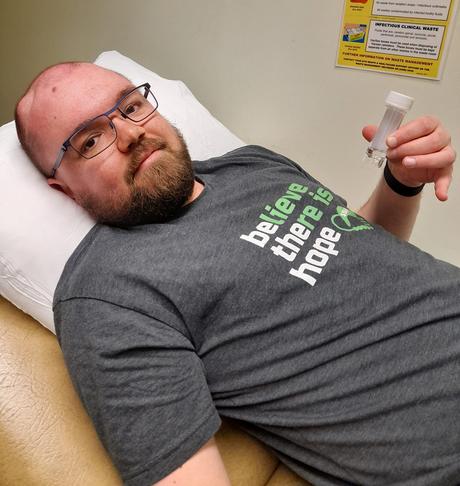Superficial Siderosis and CSF Leak - An Intertwining Complication
Superficial siderosis and CSF (cerebrospinal fluid) leak go hand in hand. If blood can infiltrate the CSF, then CSF can leak out as well, which is what it did in my case.How It Started
In August 2015 I woke up in the middle of the night with a loud screeching in my right ear which also felt like it had popped, but I was not able to un-pop it. I yawned hard multiple times, but each time my ear would a go back to that popped sensation, which felt like I was ascending upward 20,000+ft in a plane. I got out of bed only to realise I felt really dizzy and unsteady on my feet, I also had throbbing pain on the right-hand side of my head.
I took some paracetamol and the pain and dizziness soon subsided. I then went back to sleep thinking it was just a random one-off occurrence. Upon waking up in the morning, I found the dizziness and pain had now gone, but I still had the popping sensation in my right ear. I booked an appointment with my audiologist, and two days later when I saw him, he told me that I had a 20db hearing reduction in my right ear. He was concerned and wrote to my GP suggesting an urgent referral to ENT (Ear Nose & Throat) at the hospital.
Superficial Siderosis Diagnosis October 2016
Fast forward to just over a year later, and I had now been diagnosed with superficial siderosis following multiple lumbar punctures that showed blood presence in my CSF and an MRI scan which showed iron deposition on my brain. However, no source of bleeding was found. My neurologist attributed the superficial siderosis to the previous posterior fossa (back of the head region) brain surgery which I had to remove a tumour in 1998 when I was 8 years old.
I still had the popping sensation in my right ear and noticed that lying down flat was the only thing that would give me some resolve. It would also help to ease the dizziness and headaches that I was getting. After reading up on superficial siderosis I was not convinced that positional headaches and ear-popping were characteristic of the symptoms. I'd joined an online help group for superficial siderosis so asked if any other people had similar symptoms. I was quite amazed to find that no one else was experiencing these symptoms, which made me think there must have been something else going on as well. I then stumbled upon a CSF leak group on Facebook and could tell straight away that I had arrived at the right place.
Could I Have a CSF Leak Even Though the MRI Didn't Show One?
I think that by now I had already convinced myself that I had a CSF leak. Speaking to others with superficial siderosis and reading the various symptoms in the CSF leak help group, had swayed my mind. I know they say you shouldn't believe everything that you read online, but with superficial siderosis being as rare as it is, doctors who are knowledgeable in the condition are hard to come by. My doctor had told me that I was the first case he had ever come across and had to refer to his colleague in London for advice.
I had already told some of the nursing staff how I was convinced I had a CSF leak as well, but the challenge for me was to convince the doctors that it wasn't just the superficial siderosis causing me problems.
The Shunt Saga
I found myself emailing my neurologist every week in the first few months of 2017. Writing lists of the symptoms which I was certain weren't down to the superficial siderosis. Eventually, my neurologist agreed to bring me in for ICP monitoring, but before this could happen my VP shunt blocked. The next thing I recall is waking up in A&E, which I thought was strange as I had never regained consciousness from a shunt blockage until I had undergone surgery to unlock/revise the shunt. My first thought was that there must be a CSF leak relieving the pressure in my head. A CT scan was carried out showing ballooning ventricles, confirming hydrocephalus and the need for neurosurgical intervention.
It was early hours of the morning, and I was transferred to the usual hospital for emergency surgery to unblock the shunt. I was drowsy, but still conscious and can remember everything that happened. This was a much different hydrocephalic state to what I had ever been in before. I met the on-call surgeon first thing in the morning, he wrote down his email address on a piece of paper for me and said after the surgery he would investigate the ongoing issues I was having. When I was sent for a CT scan after I'd had the surgery, I bumped into my neurologist who said he had been discussing with my regular surgeon about bringing me in for ICP monitoring. He seemed very surprised to see me in admission and said he would speak with the on-call surgeon who operated to unblock my shunt.
A week or so after I was discharged, I emailed the surgeon who unblocked my shunt after the A&E visit. He told me he wanted to carry out ICP monitoring and would now be taking over my care.
Intracranial Pressure (ICP) Monitoring
Between the period of June 2017 and the end of 2018, I underwent ICP monitoring on multiple occasions.
ICP monitoring is where a pressure sensitive probe is inserted into the skull to record the pressure within the head. It's a quick operation which takes around 15 minutes for the surgeons to insert the probe under general anaesthetic. The probe is connected to an external monitor that records the pressure levels. It can be quite uncomfortable having to move around in different positions with the 'ICP bolt' attached; and because ICP fluctuates depending on whether the patient is upright or lying down, it's best to get a variation of readings in different positions, and to also note any activity that is being carried out. -Rhys
 ICP monitoring- ICP Bolt
ICP monitoring- ICP Bolt Each time I underwent ICP monitoring, it showed the pressure was low when I was upright. It would usually drop down to as low as -25mmhg if I was upright for a significant amount of time. I could also feel the low-pressure headaches kicking in the longer I was upright. The best and probably the only resolve for this was to lie down completely flat without a pillow. Whilst I was lying flat, the pressure readings on the monitor would increase to normal levels, which corresponded with my symptoms.
A Programmable Shunt Valve with Anti Siphon Device
I told my surgeon that I felt I had a CSF leak as well as superficial siderosis, but he firstly wanted to rule out the over-drainage of my VP shunt. ICP monitoring had confirmed the pressure in my head was low, and I also had the characteristic symptoms of intracranial hypotension (low pressure), that resolved when lying flat. I had a minor operation to change the valve on my shunt to a more modern type which was programmable and had a built-in anti-siphon filter. Prior to this, I had a fixed pressure shunt valve that had been in place for over 15 years. I found myself back and forth for multiple weeks towards the latter end of 2017, each time to have the resistance on the shunt valve increased. I never really noticed any change in the popping in my right ear, other than by now I was starting to get popping in my left ear as well. My hearing was also continually deteriorating, from what I gather was a combination of both the superficial siderosis and undiagnosed CSF leak.
CT Cisternogram
After having no joy with increasing the pressure on the shunt valve, at the beginning of 2018, my surgeon booked me in for a CT cisternogram. A cisternogram is where a contrast dye is inserted into the cerebrospinal fluid via a lumbar puncture. This can help to highlight any defects such as a CSF leak. Once the contrast dye was inserted, I was placed onto a table and tilted back and forth so the contrast dye would reach my head. Immediately after this, I was sent for a CT of my head and spine to look for any defects. Unfortunately, the scan didn't show a leak.
A Second Neurosurgical Opinion
By now I was getting frustrated as I wasn't getting anywhere, and continually having to lie flat to ease the symptoms. I sought a second opinion from a private neurosurgeon in a different area to see if he could suggest any other options. The surgeon was satisfied with the care I had received, and the only thing he could suggest was a gravitational anti-siphon device to add onto my shunt. The idea of this device is that would stop the shunt siphoning/over-draining CSF when I was upright. It seemed like a great idea at the time because I knew that I got resolve from the symptoms when lying down flat.
Tying off the VP Shunt
Back at the regular hospital, my surgeon wanted to tie off the shunt to see if it would help and give him any further insight into my problems. Basically, this would have the same effect as if I were to have the shunt removed as a kink would be made in the catheter to stop the CSF draining. It would mean I'd have nothing to drain the CSF when the pressure in my head became too high; but because the pressure was too low, my surgeon questioned whether I needed the shunt at all. I must say, I was quite worried about this as I had the shunt fitted when I was 11 due to raised pressure in my head due to CSF build-up (hydrocephalus). My worry was that if I needed the shunt, would tying it off cause me any harm? I was willing to let my surgeon try this because I had been lying down most of the time for the past year and wanted to get my life back.
I proceeded to have the shunt tied off, and at the same time had an ICP monitor fitted to record the pressure in my head. I can't remember much after this as I had developed (what I was told was) low-pressure hydrocephalus, and the ICP monitor wasn't showing correct readings. The surgeons proceeded to untie the shunt due to the development of hydrocephalus. I regained consciousness and my surgeon was very upset that I had gone into a hydrocephalic state. He pulled me and my mum into a room and said he would look to fit the gravitational anti-siphon filter into my chest area. This operation would be relatively simple and not put me at risk, so even after the scare of getting low-pressure hydrocephalus, I was happy to go ahead with it.
Gravitational Antisiphon Device Fitted to Shunt
In April 2018 I was admitted to hospital to have an anti-siphon device added to the shunt. I didn't get my hopes up though, as I still believed I had a CSF leak, even though the cisternogram didn't show one. It was a simple operation and worth trying as the surgeon I saw for a second opinion had also recommended it.
After the anti-siphon device was fitted into my chest area on the shunt tract, it was back to the same routine as when I had the shunt valve replaced in my head. Back and forth the hospital every week or so to have the resistance on the antisiphon device increased to the next level. The outcome was also the same as the valve in my head, where it had no effect on the popping in my ears, or the low-pressure headaches.
A CSF Leak Expert
After having the antisiphon device on the shunt adjusted multiple times over the next few months, there was no change at all. I sought a further opinion from a CSF leak expert who I found through an online CSF leak help group. I was so glad that I took the journey from where I live in South Wales up to the North Midlands, as the doctor recommended that I have an Indium 111 DTPA radionuclide cisternogram, which is where radioactive dye is inserted into the spinal fluid as opposed to normal contrast dye. A gamma scan is then carried out (opposed to a CT scan used in a standard cisternogram). The radioactive dye will stay in the subarachnoid space for a few days before it is depleted. This makes it more efficient for picking up any CSF leaks as traces of the dye will be left behind in the areas it has passed through. Scans are carried out of several days to get multiple images for comparison.
A Violent Throbbing Sensation
Shortly after my appointment with the CSF leak expert, I attempted to do some non-vigorous exercise on the stationary bike. I had been doing this for a few weeks and tolerating it just fine. However, this time the back of my head began to violently throb. I led down on the sofa and shortly afterwards my parents rushed me to A&E at my local hospital, where I was put on IV fluids and tilted backwards on a bed, so my head was lower than my legs. The neurologist who suggested the lumbar puncture that helped to diagnose my superficial siderosis came to see me. He completely agreed that it was intracranial hypotension and wanted me to be transferred to neurosurgery at the other hospital. Unfortunately, my consultant neurosurgeon wasn't in, but the neurologist pushed for me to be transferred.
Whilst I was led in bed waiting to be transferred to neurosurgery at the other hospital, I had an email from Dr. Levy, who is knowledgeable in superficial siderosis. A few months prior I had posted him copies of my MRI scans to get an expert opinion. He reviewed my scans there and then, all whilst I was waiting to be transferred. He said he was 'almost certain' the leak of blood (that caused the superficial siderosis) was at the back of my head where I had a pseudomeningocele(an abnormal collection of CSF outside the protective layer of the brain and spine), due to it being the area with the most hemosiderin (a protein compound that stores iron). Anyway, after explaining about the hypotension and multiple attempts to adjust the shunt, Dr. Levy suggested I speak to my surgeon about exploratory surgery at the back of my head to look for a tear in the dura (the protective layer around the brain and spine) which could be the source of a leak causing the low pressure and/or bleed.
Back to Neurosurgery
 Indium-111-DTPA-Cisternogram
Indium-111-DTPA-Cisternogram After eventually being transferred to the other hospital, and under the care of the neurosurgeons, they attempted to adjust the anti-siphon device in my chest; but it was stuck. Once my consultant neurosurgeon returned from annual leave, he tried to adjust the anti-siphon device himself but was unable to do so. I told my consultant about the email from Dr. Levy, and after consulting his colleagues he said he would start from scratch and carry out another CT cisternogram to look for a leak. A few days went by I finally had the scan, and once I was back in my cubicle lying flat, my surgeon rushed in to say I had a CSF leak at the back of my head. He said there was a 6cm hole and he would need to order a PEEK ( Polyether ether ketone - used for medical purposes to repair bone defects) implant to replace the bone that had been removed when I had a craniectomy to remove the brain tumour in 1998. I was discharged and on call ready to be readmitted for when the PEEK implant arrived from Germany. The PEEK implant was made to fit the cavity at the back of my head using the dimensions taken from my MRI scan.
I finally got the call and was brought in to have the PEEK implant fitted, in what I was told wasn't a high-risk operation like the shunt revisions I had previously undergone. Immediately after the operation, the popping in my ears began to subside, and my surgeon said, 'you will never have a problem with that pseudomeningocele again'. I had an indium-111 DTPA cisternogram a few days afterward which showed there was now no leak.
Two Birds with One Stone - 2019 Onwards

In 2019 I had my VP shunt removed and an ETV (Endoscopic third ventriculostomy) was carried out. The ETV appears to have stabilised the pressure in my head after I had developed a low-pressure state presumably from the CSF leak and shunt complications. A further two lumbar punctures have shown that my CSF is now clear and not contaminated with blood. ICP monitoring at the end of 2020 confirmed that the pressure in my head was now at normal levels. The PEEK implant cranioplasty looks to have not only stopped the CSF leak at the back of my head but has also stopped the bleed which caused the superficial siderosis.

